Physical Security Elements
Abstract
Chapter 7 covers the hardware that make electronic security systems interface with the physical world. These include doors, frames, electrified locks, vehicle portal control mechanisms, and other physical barriers. Physical security is the most basic countermeasure and one of the most effective. In fact, electronic security systems have no real benefit without these elements.
This chapter includes information on basic physical security and basic physical security skills and tools including doors, frames, locks and hardware, and egress and security issues related to those.
Door hardware includes the bits and pieces that hang the door in the frame and adapt it to its operating environment. These include hinges and pivots, handles, levers, push bars and paddles, door closers and door coordinators, and automatic door operators. Door frame types include hollow metal, formed aluminum, extruded aluminum, wood, and frameless glass openings. Specialty frames include high-security frames and blast and soundproof frames. Occupancy ratings determine what kind of doors must be used, the widths of corridors, the types of door frames, and the appropriate door hardware.
Pedestrian gates are the openings in fences and buildings that are not intended to defend against the weather. Pedestrian gates include chain-link gates, estate-type gates, and reinforced frame gates.
Common electrified locks include electrified mortise locks, magnetic locks, strikes, and electrified panic hardware. Push to exit buttons or panic bar switches should be used with all magnetic locks, in addition to any other automatic unlocking exit method. All electrified locks should use an interface to the building’s fire alarm system to ensure that locks are unlocked automatically in the event of a fire in the building, thus ensuring free egress. Delayed egress hardware provides for securing an exit door against improper use while ensuring that it is available for exit during an emergency. For all electrified locks, fire authority approval is required. Local codes vary, so the designer should know the local interpretation of national and state codes and any local codes. Electrified panic hardware ensures that high-volume exit doors can function in an emergency while providing access control. Specialty door hardware includes monitor strikes, Blumcraft hardware, and HiTower locks. Other specialty locks include high-security locks, such as high-abuse locks, electrified dead bolts, and four-point electrified locks. Locks to avoid include electrified cylinder locks and lightweight strikes. NFPA Section 101 is the primary reference for life safety regulations and should be known by all security system designers. It is a good rule of thumb to design electrified locks for use with no special knowledge and free mechanical egress.
Introduction
Physical security is the most basic countermeasure and one of the most effective. When one of my early mentors was extolling the virtues of electronic security, I stated that I believed that physical security was more important than electronics. When my mentor challenged me to cite an example, I asked him to imagine a steel frame structure out in an empty field. On the structure would be hung video cameras, intercoms, alarm sensors, card readers, and locks, but without the benefit of walls, doors, and other parts of the building—just the steel frame in a field to support all these devices. I asked, “We have a complete security system. But does the security system offer any security?” Of course not, he said, and conceded the point.
Physical security is anything that prevents unauthorized access to an asset by means of a barrier, be it a wall, door, rising bollard, or fence. Electronic security is any element that uses electronic components to deter, detect, assess, communicate, or assist in the response to an event. There is no security without physical security. Effective integrated security system design requires a comprehensive knowledge of physical security.
This chapter includes information on basic physical security and basic physical security skills and tools including doors, frames, locks and hardware, and egress and security issues related to those.
Basic Physical Security
The most basic physical security is the physical architecture and landscaping of a facility. Whether it is a 20-foot-high storm wall that prevents vehicle access, a fence that deters and delays access to the property, the walls and roof that prevent or delay entry without special tools, or locked doors or windows with bars that delay offenders, these all form the basis on which the designer can build a useful integrated electronic security system. The natural and existing physical security of a facility will also define what type of electronic security measures are required to achieve adequate security. For example, imagine an atrium hotel where each hotel room door opens onto a very large open space. This arrangement will require individual electronic locks on each hotel room door to secure the patron’s assets and person. On the other hand, a research and development department that is in its own building may only require a few alarm points and locks on its perimeter and access control leading from its one reception lobby.
Basic Physical Security Skills: Knowledge of the Tools
Each type of electronic security system has its own types of components (we will call them tools) that are used to build the system. For access control systems, the most basic tools are doors and electronic locks.
Door Types
Security door hardware has often been the bane of security system designers. There are literally hundreds of combinations of door position switches, electrified locks, electric hinges, and automated door operators and a seemingly endless combination of hardware types to perform virtually every function known to man. A solid understanding of doors and electrified door hardware is necessary in order to be competent in designing integrated security systems.
First, it is useful to understand how architects select door hardware. Architects categorize buildings by classes. A Class A building has finely finished lobbies and corridors and is filled with fine appointments. Class B buildings are suitable for receiving guests and will make a pleasant impression, but they do not have the expensive architectural features of a Class A building. Class C buildings are more serviceable for office/warehouse functions, where there is a mix of public and utility functions within the same space. Class C buildings may be provided with both utilitarian and basic public amenities. Both Class A and Class B buildings will have their finer elements in the front-of-house (public) areas, and Class C building will have these elements in the back-of-house (back corridors and loading dock) areas.
Door types are selected by the architect based on strength requirements and aesthetic factors. For example, an architect would never design hollow metal doors for the front lobby of a Class A office tower because they do not fit the design ethic of the building’s lobby. Similarly, the architect would not design plate glass doors for the loading dock because they do not have the strength required to stand up to carts banging against the doors, and there is no value to being able to see through the doors; in fact, it would be a liability because it would assist criminals to surveil the building before making a simple entry by breaking the glass in the door. There are really only a few types of doors, but there are many variations of these few. Variations include door handing, door hinge types, door openers and closers, door coordinators, and some other fairly arcane variations of these. Understanding doors is the first step to access control system design competency. Door types include
• Solid core
• Glass storefront
• Herculite™
• Specialty doors, including Total Doors™, balanced doors, and historical doors
Hollow Metal Doors
Hollow metal doors are one of the most common types of doors used in commercial and industrial environments. A hollow metal door is composed of a steel frame that has steel panels laminated to both sides. The door is typically equipped with mounts for hinges and a pocket for a mortise lock.
Better hollow metal doors may also be equipped with a steel tube from the center hinge to the mortise pocket for wiring an electrified mortise lock and an electrical pocket at the top of the door for mounting a magnet for a door position switch.
Hollow metal doors are robust doors that can take a beating. Depending on door height, they may be equipped with three to five hinge mounting points. Hollow metal doors may also be furnished with a plastic laminate, wood veneer, or stainless-steel finish to achieve a desired aesthetic effect.
Hollow metal doors are often supplied with a hollow metal frame, together creating a fire-rated assembly. Fire ratings of 60, 90, and 120 minutes are available.
Typical electrified locks for hollow metal doors include electrified mortise locks, magnetic locks, and electrified panic hardware. Magnetic locks may be either surface mounted or concealed, and electrified panic hardware can be applied with either surface or concealed vertical rods. Electrified panic hardware may be of any type (with mortise lock, rim type, or with vertical rods).
Hollow metal doors are very easy to use with automatic door operators. Five or seven knuckle hinges are the most common hinging methods for hollow core doors, although pivots are not uncommon. More hinges are better than fewer for any security door application.
Solid Core
Solid core doors are wooden doors that are fully filled with wood or wood composite materials inside a frame of wood. Solid core doors are often used in commercial applications, particularly in high-rise office building corridors. These are mostly applied to tenant suite doors rather than on the main fire corridor, where hollow metal doors are more common due to their lower cost and often higher fire rating. Solid core doors are in common use for the interior doors of Class A office buildings.
Solid core doors are usually mounted into a pocket for a mortise lock unless panic hardware is planned. Such doors may also be drilled through the center from the center hinge to the mortise pocket for wiring an electrified mortise lock. If a door position switch magnet is required, this will typically be drilled in the field.
Solid core doors are robust doors that can withstand heavy use. Depending on door height, they may be equipped with three to five hinge mounting points. Solid core doors may also be furnished with a fine wood laminate to achieve a desired aesthetic effect.
Solid core doors are usually mounted into either a hollow metal frame or formed aluminum frame, together forming a fire-rated assembly. Fire ratings of 60 and 90 minutes are commonly available with hollow metal frames, and 60-minute ratings are common with formed aluminum frames.
Typical electrified locks for solid core doors include electrified mortise locks, magnetic locks, and electrified panic hardware. Magnetic locks may be either surface mounted or concealed, and electrified panic hardware can be applied with either surface or concealed vertical rods. Electrified panic hardware may be of any type (with mortise lock, rim type, or with vertical rods).
Hollow metal doors are also easy to use with automatic door operators. Standard five or seven knuckle hinges are the most common hinging methods for solid core doors, although pivots are not uncommon. More hinges are better than fewer for any security door application.
Glass Storefront Doors
Glass storefront doors are common public entry doors for Class B and C commercial buildings. These doors are obvious by their aluminum frame with a tempered glass panel. Although they do not have the aesthetic appeal of Herculite doors, storefront doors do provide light for lobbies and a more open feeling to public areas as one enters the building. It is common to see storefront doors on medical, commercial, government, office, storefront commercial spaces, and other types of buildings in which glass doors make a pleasant point of entry.
Storefront doors are reasonably robust and can stand high daily use. They are not, obviously, security doors because one can make entry by breaking the glass. Storefront doors are typically hinged with pivots rather than hinges, although hinges, including full-height hinges, are not unusual.
Typically, storefront doors are equipped with panic hardware—a pair of handles or a handle and a push bar. Common electric locks include electrified panic hardware (vertical rods are most common) and magnetic locks. A very rare version of the storefront door is actually assembled from two glass panels with an aluminum panel in the center wherein is mounted a mortise lock.
Storefront doors can be easily automated, and these are often found in grocery stores and other commercial applications. Storefront doors are almost always equipped with a mechanical deadbolt at the strike or bottom of the door.
Herculite™ Doors
Herculite™ doors are solid glass doors that are immediately recognizable by the fact that they have no metallic frame on their vertical sides. They are commonly used in Class A commercial spaces as the main lobby entrance. It is not uncommon to find Herculite doors with a steel band on the top or bottom (or both) to facilitate the mounting of security locking hardware, although this is not always so. Herculite doors are almost always equipped with a mechanical deadbolt at the bottom of the door.
Herculite doors are usually electrically locked using concealed or surface-mounted magnetic locks. When surface-mounted magnetic locks are used, this is an indication of a lack of awareness or interest on the part of the door hardware or security system designer because concealed or full-width surface locks are much more in keeping with the high aesthetics of Herculite doors.
Two other electric locking options are the use of standard electrified panic hardware with surface-mounted vertical rods and the far more elegant Blumcraft™ locks (see Electrified Specialty Locks).
Herculite doors are not well suited for automatic operators due to the point stresses on the doors, although this is sometimes done. The doors are made to be leveraged from the door handle, not the top of the door, where the constant torqueing can weaken the door, and they have been known to break as a result of this. I assure you that there is little more impressive than to witness a 12-ft high Herculite door disintegrating into 10,000 bits of glass pebbles from such abuse.
Herculite doors are also unique in that there is always approximately a 1/4-in. (1 cm) clearance between the doors. This allows for easy insertion of numerous types of objects that could trigger an infrared request-to-exit (REX) detector that might be mounted above the door on the inside. This will often cause the door to open from the outside without a card credential. Also, the opening will be recorded as a legal exit because the REX detector initiated the opening. There are three ways to prevent this:
• Move the REX detector away from the door approximately 5 ft. This is not recommended because it can cause the door not to open if people gather at the door to say goodbye, allowing enough time for the original exit sense to time out. People have panicked in such circumstances, in some cases yanking on the door’s handle repeatedly until the door shattered.
• Utilize mechanical egress hardware such as electrified panic hardware or Blumcraft hardware. Blumcraft hardware has its own vulnerabilities, including use of a coat hanger to pull the exit handle.
• Use a pair of exit detectors, including a secondary motion detector sensing approach to the door and the REX detector above the door. By setting the sensitivity on a microwave motion detector such that it will only trigger when under the presence of a human (child or adult) and not with the mere presence of a newspaper stuffed through the slot, this kind of vulnerability can be mitigated.
Specialty Doors
There are a number of doors made for unique applications.
Revolving Doors
Revolving doors are a familiar sight at airports and large department stores. They facilitate rapid movement of people in and out of the building while keeping cold winds out of the warm interior space. They can also be very useful in access control because only one person can typically use each quadrant at a time.
All manufacturers of revolving doors make card reader interlocks to facilitate the passage of only one authorized user at a time. Some interfaces are more elegant than others.
A good interlock should incorporate a pawl in the rotating mechanism that is released for one-half rotation to allow passage of a person entering the door. It is important that the door’s interlock is sophisticated enough to ensure that the user will not be locked into the side of the revolving door but can in fact always exit the other side.
Better interlocks are also configured to prevent the passage of more than one person and the simultaneous use of the opposite side of the door for ingress while egress is occurring under card authorization.
Revolving doors are normally access controlled both ways—that is, not just for entry or exit, but both will be under access control. The door may be operated on a schedule or may be on access control at all times.
Best practices indicate the use of a delayed egress door panel (also under access control) next to the revolving door to permit entry or exit by a handicapped user. The delayed egress function ensures that the door will not be used to bypass the revolving door, and the door’s card reader will be programmed only to permit use by handicapped cardholders (Fig. 7.1).
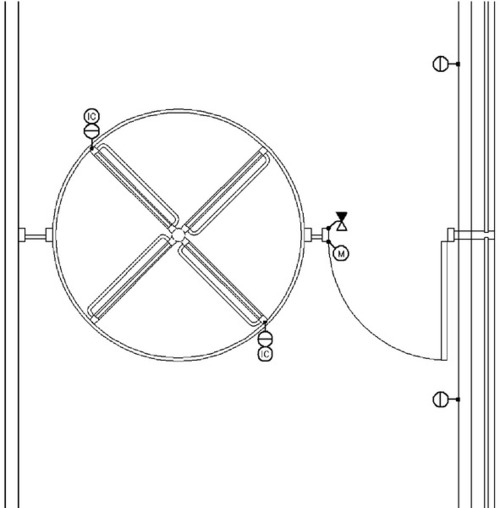
Total Doors™
Total Door™ is a registered trademark for a very unique type of door. Total Doors are shipped as an entire assembly, including the frame, electrified locks, and other hardware. Unique attributes of Total Doors include a full-height hinge, an integral panic hardware locking system, and a full-height locking latch assembly that operates like a full-height thumb and finger gripping the opposite door of a pair. The locking mechanism is quite secure and the doors are uniquely able to adapt to difficult frame environments, particularly where other doors might often need realignment.
Total Doors can be easily configured to operate as a bi-swinging pair of doors with no center stile (a very unusual configuration for any other type of door) and can be configured with automatic operators (Fig. 7.2).
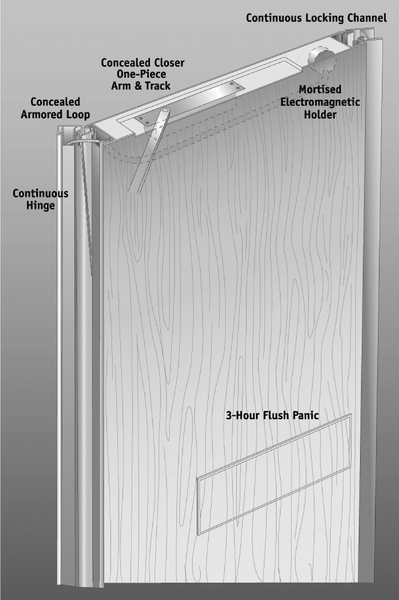
Balanced Doors
Balanced doors are a relatively rare type of door that is mainly used at the main entry of a building to its lobby. These doors require very little effort to open because they are balanced on articulating arms top and bottom rather than on normal hinges. Balanced door articulators are usually placed on very heavy door panels to make their operation a very light task, similar to much lighter doors on normal hinges. Balanced doors are often very ornate and make use of fine materials. Their objective is often not only an elegant function but also elegant style.
Balanced doors are very difficult to control with electrified locking hardware because they do not open and close like any other type of door. Surface-mounted magnetic locks have been used with success, whereas concealed magnetic locks have not due to the fact that balanced doors are not intended to close precisely. Due to the elegant style objective of balanced doors, full-width surface-mounted magnetic locks are a good choice.
Historical Doors
There are many types of historical doors that are both beautiful and can be very difficult to configure with access control or automatic operators. In general, historic doors have high aesthetic and historic value and should not be modified if at all possible. Historic doors are often equipped with unique and beautiful historic locks that have no comparison in modern locksets, making their use challenging.
One common type of historic door lock is the case lock. The case lock is like a mortise lock without the mortise pocket in the door. In lieu of the mortise pocket, the door is cut out where the lock sits, and the lock is fitted into the cutout and bound in place by a very tight friction fit between two oversized escutcheons that are tightened against each other, with the door and the lock fit tightly in between.
There is no modern electrified lock equivalent, and although case locks have been modified to be electrified at very great cost and with no attached warranty, there are other options. One is the use of a very unique electric strike that, instead of falling away like a normal strike, pushes the latchbolt out with a solenoid or cam. Although these strikes are difficult to find, they can easily be adapted to work with case locks.
The second most common type of historic lock is the rim lock (surface-mounted lock). Depending on the value of the door and the visual and historical aesthetics, a variety of auxiliary electrified locks can be fitted into the housing of the original rim lock.
I have encountered dozens of types of historic doors and locks, each more unique than the last. Historic doors and locks require a solid imagination and attention to detail in order to secure without destroying the value of the doors or the locks.
Security Doors
Security doors are a superset of hollow metal doors that are equipped with very robust door frames, door panels, and door hinges. Security doors are extremely robust and intended to withstand constant abuse. Security doors can be found in detention facilities, public housing facilities, and anywhere the architect or security designer wants to be assured of solid physical protection.
Security doors can be locked with mortise locks, magnetic locks, or electrified panic hardware. A good choice is to use electrified deadbolts and/or a four-point locking system to prevent frame spreading or opening the door with tools. This is a good choice for loading dock or rear perimeter doors where the burglar may have time to attack the defenses. Few burglars will continue to attack a door after realizing that it is not vulnerable to conventional methods and tactics.
Security doors should be used with high-security door frames. These combinations will typically carry 2-hour fire ratings or better.
Blast Doors
Blast doors are a type of security door that is designed to withstand severe atmospheric overpressures as well as severe attacks from physical tools. Blast doors have extremely robust door frames, panels, and hinges and are almost always configured such that the frame is interlocking with the door to prevent the intrusion of atmospheric overpressures. Blast doors are rated in atmospheres. Blast doors are commonly secured with very robust magnetic locks.
Soundproof Doors
Soundproof doors are used where noise isolation is essential, such as in recording studios, vivariums, and sometimes hospitals. Soundproof doors are typically thicker than conventional doors (2–6 in.) and are closely fitted to their door frames to ensure that no path of sound exists between the door and the frame. It is common to see plunge operators on soundproof doors, similar to those found inside walk-in freezers. Magnetic locks are a common choice to secure soundproof doors.
Door Hardware
Door hardware is the bits and pieces that hang the door in the frame and adapt it to its operating environment. Door hardware includes hinges, handles, closers, coordinators, automatic operators, locks, and the like. Very few security system designers know very much about door hardware. The best ones know a lot.
Hinges and Pivots
A hinge comprises a pair of small plates formed to fit to the door and the frame and to allow for a pin to pivot the plates and thus the door from closed to open. Hinges mount on the side of the door opposite the handle.
A pivot is a pair of assemblies that mount at the top and bottom of the door and allow the door to pivot along a vertical line created between the two devices. The bottom pivot supports the door’s entire weight. It is made of two plates that swing apart like scissors around a single pinned hinge that lies just outside the door. One plate is mounted to the threshold, and the other is mounted to the bottom of the door. On the top of the door, this assembly is repeated, except that it only steadies the door in place and does not bear any weight. The bottom pivot may be configured with a door assist or door closer (sometimes a combination of the two) to make the door easier to open and close.
Full-height hinges look like piano hinges turned on their side and are formed of two full-height metallic panels with a hinge pin. Full hinges are largely immune to torqueing of the door or settling of the frame. They are also less vulnerable to any attempt to remove the hinge pin. Full-height hinges are also useful for extremely high-traffic doors where normal hinges might show aging in a few years.
Handles, Levers, Push Bars, and Paddles
Handles, levers, push bars, and paddles facilitate the opening and closing of the door by pushing or pulling on the device. Handles can be used both inside and outside the door to push on or pull toward the user. Push bars are limited to the inside of the door.
Handles may be passive or attached to and designed to operate a mechanical lock. Levers are handles that turn to activate a mechanical lock. Push bars may also be passive or active, where the active bars are part of emergency egress (panic) hardware. Paddles are a small version of a panic bar, where a simple paddle is placed at the opening side of the door and, when pushed or pulled, it releases a latchbolt.
Door Closers
Door closers are pneumatic cylinders that facilitate the slow and steady closing of a door to a closed and latched condition. Door closers can be located in the threshold of the door or within the top header or on the outside of the top of the door and frame.
Door Coordinators
Door coordinators ensure that double doors close in a specific order so that the passive leaf of the pair is closed before the active leaf closes and latches into it. Door coordinators may take many forms. One common form consists of a lever that drops down slightly from the top of the frame to hold the active leaf open until the passive leaf closes, also causing the lever to lift, and thus allowing the active leaf to finish closing.
Automatic Door Operators
Automatic door operators are motorized assist units that operate articulating arms at the top of the door, facilitating the opening of the door(s). Automatic door operators must be carefully coordinated with the help of a door operator interface circuit so that the electrified locking hardware, access control system, and door operator perform a proper sequence of operations for the safety of the user and the door hardware (especially the automatic door operator):
• The card is read or the REX device initiates an open request.
• The access control system closes a dry contact linked to the door operator interface circuit.
• The door operator interface circuit sees the open request and releases the electrified door lock.
• After a proper delay (typically 250 msec) to ensure that the electrified door lock has finished its action, the door operator interface circuit will activate the automatic door operator, which then opens the door.
• When the door recloses, the door operator interface circuit senses that the door is closed and reactivates the electrified door lock, locking the door.
The sequence is ready to begin again. This sequence ensures that the automatic door operator is not attempting to operate against a locked door, which is very hard on the door hardware and can cause the automatic door operator and electrified door lock to fail prematurely. I designed one of the first commercially available door interface circuits still in use by a major automatic door operator company.
Door Ventilators
Door ventilators are louvered panels that are placed in the bottom of a door to facilitate cooling of the contents of the room (often used in telecommunications and electrical rooms). Door ventilators are potential security vulnerabilities if not secured with a reinforcing grille.
Door Frames
Many of the previously discussed door types can be fitted into a variety of the common frame types.
Hollow Metal
Hollow metal frames are among the strongest and most secure types of common frames. Hollow metal frames are formed of strong steel and have a subframe that enables them maintain their form over time and with the constant stresses of door openings.
Hollow metal frames are always equipped with hinge mounting plates and strike pockets. They can also be equipped with electrical boxes fitted for an electrical hinge, Hi-Tower lock, and concealed magnetic door position switch. The security systems designer should understand that modifying the frame to accept these types of electrified door security elements may in most cases void the door assembly’s fire rating and should be avoided.
Hollow metal frames can be used with any type of door but are most commonly used with hollow metal doors and solid core doors.
Formed Aluminum Frame
Formed aluminum frames are commonly used to mount storefront doors and solid core doors. Formed aluminum frames comprise a lightweight aluminum panel formed to the specific shape of a door frame. Some manufacturers form the frame by a method of extrusion, not by bending a panel.
Formed aluminum frames can be used with hinges or pivots. These frames can be easily damaged with tools, often resulting in the removal of the door. Formed aluminum frames are inadvisable for use in high-security applications but may be used in simple access control environments. Formed aluminum frames may be fire rated with very low ratings.
Extruded Aluminum Frame
Extruded aluminum frames are typically formed as a closed box frame and are commonly used in storefront door mounting applications, next to a window wall. Extruded frames are stronger than formed aluminum frames but are not a significant delaying mechanism against a burglary attack using tools of force. Obviously, in storefront door applications, the glass door is the weakest link. Extruded aluminum frames are not often fire rated.
Wood Frame
Wood frames are sometimes used in commercial security applications, but their use is inadvisable. Unlike hollow metal frames, wood frames cannot stand up to continuous rugged use. It is not uncommon to have to reinforce wood frame hinges or replace the frames due to wear and tear. Wood frames cannot defend against any attack using tools of force, and they do not easily adapt to electrified hardware because the installation of such hardware often corrupts the structural integrity of the door frame. Wood frames are not often fire rated.
Frameless Glass Opening
Herculite doors are generally mounted into a frameless glass opening using top and bottom pivots.
High-Security Frames
A variation on hollow metal frames, the high-security frame is structurally reinforced to withstand determined attacks with tools of force.
Blast Frames
Blast frames are highly reinforced frames intended for use with blast doors.
Soundproof Frames
Soundproof frames can be made from either hollow metal or wood (usually wood) and are designed with gaskets to hold the door in the frame in a manner that does not allow sound to travel between the door and the frame.
Pedestrian Gates
Pedestrian gates are openings in fences or buildings that are not intended to defend against weather.
Chain-Link Gate
The most common type of pedestrian gate is in the form of a bent-tube frame covered with chain-link fabric. Common locks include magnetic locks, electrified panic hardware, and electrified mortise locks. Special care must be taken to ensure a free path of egress from the protected area and that an intruder cannot improperly release the electrified lock from the outside. This is often accomplished by creating a physical barrier other than the fence fabric, such as a woven steel mesh, through which the outsider cannot reach the unlocking mechanism. Chain-link gates are simple and adequate for low-security applications.
Estate-Type Gate
Estate-type gates are made of wrought-iron frames and fabric and have a higher aesthetic appeal than chain-link gates. Locking mechanisms and precautions are the same as for chain-link gates. Their use is also indicated for low-security environments.
Reinforced Frame Gate
Reinforced frame gates are made of heavy-gauge tempered steel frames and a reinforced steel fabric. Their use is appropriate for high-security and high physical abuse environments, including public housing and public transportation systems. Common lock types include high-security magnetic locks, high-security electrified mortise locks, and robust electrified panic hardware.
Occupancy Ratings
Architectural occupancy ratings determine the kind of doors that must be used, the widths of corridors, the types of door frames, and appropriate door hardware. This is a complete study unto itself, and the implications are serious if mistakes are made.
Complicating these design issues, each community adopts its own standards, making for a maddening array of requirements even within a close geographical area. A qualified architect or fire code official should always be consulted for questions of occupancy; however, there are certain rules that seem universal:
• Fire exit doors should always swing outward so as not to allow the buildup of people trying to flee a building during a fire. Although it is common to see inward-swinging doors in commercial spaces in certain countries, regardless of what local codes permit, I do not recommend swinging exit doors inward except for residential property applications.
• Fire exit doors should always be equipped with door hardware allowing for free mechanical egress. It is unwise to rely on electronic systems to facilitate egress from a building during an emergency, and this practice violates code in most jurisdictions.
• For delayed egress doors, a fire alarm override should be configured that immediately opens the door in the event of a fire alarm in the building.
Electrified Locks
Common Electrified Locks
Electrified Mortise Locks
Arguably the most common type of electrified security lock is the electrified mortise lock. It is also one of the strongest. Manufactured by a large number of companies, this lock is the mainstay of basic electrified security programs throughout the world. A mortise lock is a lock that is placed into a pocket (mortise) in the door, giving it additional strength compared to other types of locks. The electrified mortise lock is a standard mortise lock with a solenoid-activated pawl within the lock that places a barrier to turning the lock from the outside. Typically, the inside handle is always free to turn, making egress possible at any time with no special knowledge. The solenoid is tripped to unlock the lock, allowing the outer handle to turn (Fig. 7.3).
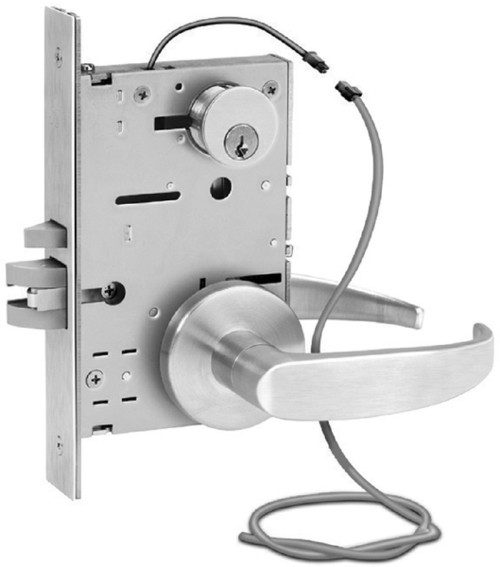
Magnetic Locks
The second most common type of electrified lock is the electromagnetic lock, commonly called a magnetic lock. These can also be very strong locks, although poor-quality magnetic locks do exist that are not as secure. A good magnetic lock should have a holding force of at least 1500 pounds. Basically formed by mounting an electromagnet to the door frame and an armature mounted to the door, the magnetic lock is available in two basic versions, plate locks and shear locks. The plate lock is the simplest and most reliable, placing the locking elements on the outside of the door such that the armature approaches the magnetic in a face-to-face fashion (Fig. 7.4).

A variation on the magnetic lock designed for high-aesthetic environments is the magnetic shear lock. This places the magnetic lock in the top of the door frame facing down, and the armature is mortised into the top of the door. The magnet draws the armature up to lock the door, and when released, the armature falls back into the top of the door, allowing the door to open. Magnetic shear locks should be used with caution because they have been known to experience mechanical failure, usually related to door misalignment. The result nonetheless is often that the door cannot be opened when the lock fails. It is inadvisable to use magnetic shear locks in any path of fire egress and especially on single doors in the path of egress where the failure of the lock could result in the inability of people to exit in a fire. I try to avoid the use of magnetic shear locks unless the door in question is not a fire exit door, absolutely nothing else will work, and the door is not the only exit from the area (Fig. 7.5).
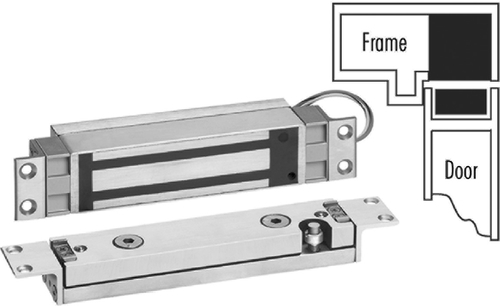
Magnetic locks are often equipped with contact sense circuits that can detect when the armature is in contact with the lock and the lock is energized. This is an effective door position switch when used in a configuration in which it can be ensured that the door will always be locked when it is closed. If the door may be closed but not locked, some of these circuits will not indicate a door closure, possibly causing a hold-open alarm because most alarm/access control panels assume that the lock and door position switches are two separate devices and function separately.
Although magnetic locks are very reliable, caution should be taken in their application to ensure that a secondary method of releasing the door is always available, usually in the form of a pushbutton marked “Push to Exit” in language acceptable to the local fire authority. We also typically design them for use with one of several types of exiting devices.
Electrified Cylinder Locks
Electrified cylinder locks are the weakest type of electrified lock (some strikes also qualify). Electrified cylinder locks have only a small cylinder and latch to hold the door and can be easily defeated by use of force. Electrified cylinder locks should not be used where security is essential.
Rex Infrared Sensor
Positioned above the door, this sensor detects the presence of a person near the door handle. The Request-to-Exit (REX) detector is normally wired to the exit sense input of the access control panel, which releases the lock, bypasses the door alarm, and logs the event (Fig. 7.6).

Push-to-Exit Button
An exit button is commonly placed near the exit door in a manner acceptable to the local fire authority. The push-to-exit button should be wired such that two circuits are activated. The first circuit would trigger the exit sense input on the alarm/access control panel, while the second would create a hardware interrupt directly to the power of the magnetic lock, thus ensuring that the lock will be unlocked regardless of the condition of any electronics (Fig. 7.7).
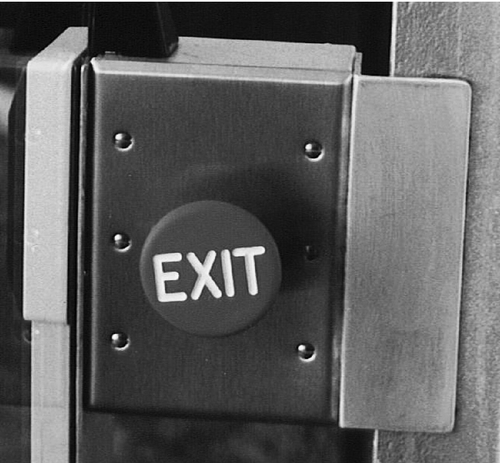
Panic bar
A panic bar can also be used as an exit switch even if it does not mechanically release the door. The use of a panic bar is a familiar visual indicator of emergency exit. Panic bar switches are usually also equipped with not only an adjacent push-to-exit push button but also a button under the panic bar to bypass the switch in the panic bar in the event of the failure of the panic bar switch. Some panic bar switches are mechanical and some sense contact with skin. The type that senses contact with skin is not appropriate where people requiring exit may be wearing gloves or use an object they may be carrying to open the door. I prefer the mechanical switch type for this reason (Fig. 7.8).
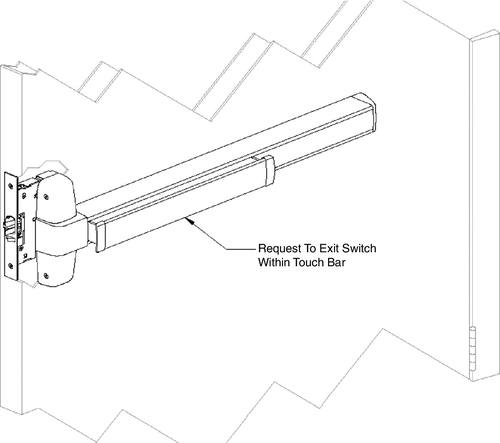
Delayed Egress Hardware
Delayed egress hardware combines a magnetic lock with a panic bar exit sensor and adds a countdown timer, audio annunciator, visual countdown indicator, and alarm signal. These configurations solve a very common conflict between fire egress needs and security needs. This problem had not been solved for many years until the development of this ingenious hardware. These locks are commonly used in schools and in back-of-house1 areas where the law requires a fire exit door but where the organization does not want to encourage the use of that door for anything other than an emergency. The door locking system requires marking in accordance with acceptable rules of the local fire authority and functions as follows:
• The person requiring exit approaches the door and pushes on the panic bar.
• An alarm sounds and a countdown timer commences, typically 10 to 15 seconds, adjustable. Typically, a numeric indicator on the magnetic lock shows the time remaining. The alarm is continuous during the countdown.
• On some systems, an audible countdown announcement accompanies the numeric indicator on the magnetic lock.
• On many systems, it is required to continue to push on the panic bar during the countdown period.
Each fire authority has special rules affecting how delayed egress hardware is implemented. Often, a variance to code is required for their use (Fig. 7.9).

Fire Authority Approval
Be certain to know, understand, and comply with all local fire authority regulations for the state, county, and city where the installation is being considered. Each municipality may have different and sometimes perplexing rules, especially concerning elevator lobbies and the use of magnetic locks. We have, for example, seen fire authorities require delayed egress hardware on a single leaf door adjacent to a revolving door that was not in the path of egress where by normal logic it should not have been required.
Fire Alarm Interface
In all cases, it is recommended to interface magnetic locks or any other type of lock that does not provide free mechanical egress to the fire alarm system such that those locks unlock automatically in the event of activation of a smoke detector, fire pull station, or sprinkler activation on the floor of the lock and the floors above and below the floor of the lock. We encourage a test key for the interface. In many communities, it is advisable simply to dump power to all magnetic locks in the building upon any fire alarm condition (Fig. 7.10).
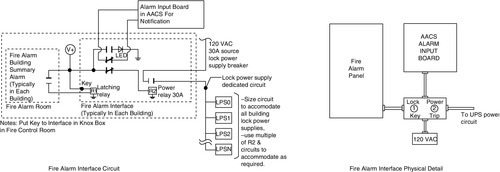
This presents an interesting challenge: How do we secure the building when anyone can simply pull a fire alarm and unlock a protected office suite? This question indicates why careful consideration of the types of locks is appropriate, and why it is important to explain these considerations to the client so that he or she can make an informed decision.
Man-Trap Door Assemblies
A man-trap is a sequence of two doors under interlocking access control, separated by a small vestibule. (Man-trap is a term you do not want to use with fire code officials, by the way; call it a vestibule.) The purpose of a man-trap is to ensure that only authorized people are entering a restricted access space. Be advised that man-traps are not legal in some jurisdictions.
Typically, the man-trap includes a normal card or keypad reader on the outside door and a biometric credential reader on the inner door. This sequence of dual credentialing and dual doors helps ensure that no one can force his or her way into a space or simply tailgate behind a valid user as the normal entry door closes behind him or her.
Man-traps have an interlocking circuit so that both doors cannot open at the same time, ensuring security through a sequential entry or exit through the two doors.
Man-traps normally involve hollow metal doors, and the security designer must take life safety into consideration. Normally, an interlock circuit ensures that both doors cannot open at the same time, and there should always be a fire alarm override to ensure egress in the event of a life safety condition. This may be acceptable in many communities, although a variance is almost always required for a man-trap interlocking vestibule. Where the normal method is not acceptable, the designer may suggest using delayed egress hardware on the doors, which is only activated if someone attempts to open one door while the other is open. Again, a fire alarm interlock is always appropriate.
Man-trap assemblies are available commercially or can be custom fabricated with interlocking relays. The manufactured variety offers some liability protection for the designer, architect, and building owner compared to the custom fabricated type, although they are often more expensive to acquire.
Electrified Strikes
Electrified strikes used to be the mainstay of electrified locks. They are in fact not a lock at all but, rather, a means of releasing a door latch remotely. Electrified strikes replace the conventional door strike into which a typical door latch closes.
Unlike a conventional door strike, which requires that the door latch be retracted in order for it to open, the electric strike unlocks the door by simply folding back to release the door latch as the user pulls the door open. It springs back instantly as the door latch clears the strike so that it is ready to receive the latch as the door closes again.
There are various types of electric strikes, but they all operate the same. They are classified into two broad categories, high security and low security, depending on the strength of the latch release pawl inside the strike.
Strikes also come in both fail-safe and fail-secure types. In the fail-safe type, power is required to energize the strike, thus locking the door. In the fail-secure type, power is required to release the strike, thus the door is always locked from the outside. In all cases, the door can be released from the inside with no special knowledge.
Electrified Panic Hardware
Electrified panic hardware is an ideal hardware to use anywhere that normal panic hardware would be used (i.e., in the path of egress). Electrified panic hardware simply combines a mechanical panic bar that will always allow exit in any circumstances, with no special knowledge, with some form of electrified lock. Several common electrified lock types are used with electrified panic hardware.
Electrified Rim Lock
The electrified rim type lock combines an electrified retracting deadlocking latchbolt with a rim-mounted strike plate. This configuration is very reliable and is commonly used in back-of-house areas where aesthetics are not so important (Fig. 7.11).
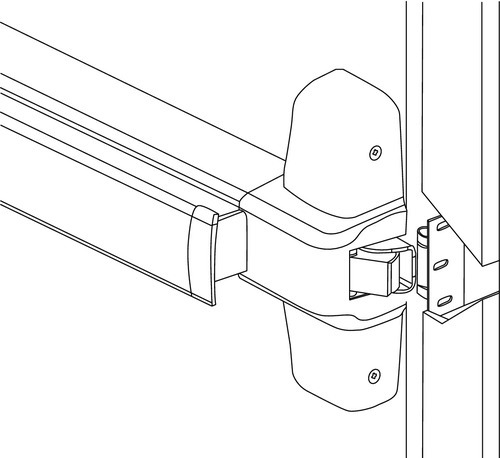
Electrified Mortise Lock
Mechanical panic hardware is combined with an electrified mortise lock to create a very secure, panic-exit-friendly and aesthetic locking system. The system includes a panic bar on the inside of the door and a normal mortise door handle on the outside of the door. Pushing on the panic bar causes a cam to rotate the mortise handle release as though a handle were used inside (Fig. 7.12).
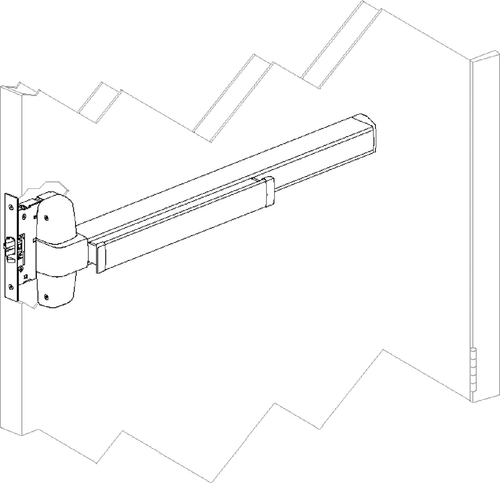
Solenoid-Released Vertical Rods
For high-traffic doors, especially in double-door pairs, and where reliable locking is required, it is common to use vertical rods to lock the doors at the top and bottom rather than at the strike. Several manufacturers make both concealed and exposed vertical rod electrified panic hardware that can reliably fit this need. Vertical rods latch into top and bottom strike plates upon returning from an open condition. Pushing on the panic bar retracts the vertical rods, allowing the door to open freely. When electrified, a solenoid releases a pawl that allows the outer door handle to rotate on some models. On others, a high-energy solenoid retracts the vertical rods completely without any outside assistance. This application is especially useful when coupled with automatic door hardware to open the door for handicapped or for the convenience of the public. For higher aesthetic installations, the vertical rods can be concealed within the door, making a very pleasing visual presentation (Fig. 7.13).
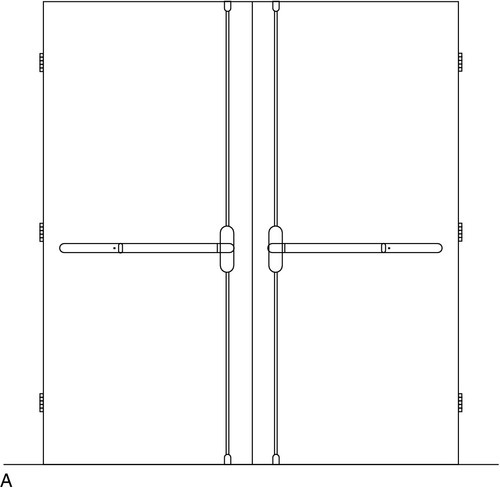
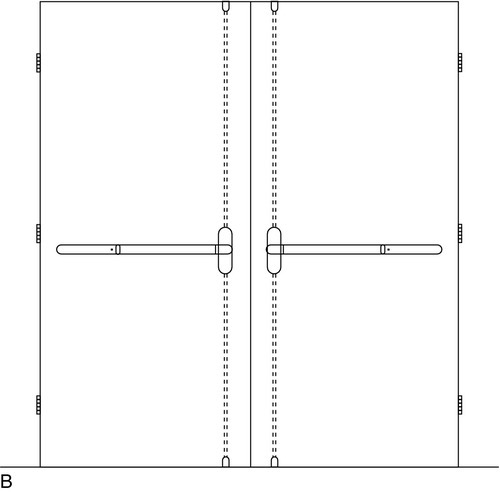
Magnetic Lock
Although some designers use a signal switch inside mechanical panic hardware to release a magnetic lock on the door, I do not recommend the use of this approach. Any electric failure of the circuitry could result in a failure of a fire exit door to open. If this combination is used, it should be wired such that the panic bar signal switch directly interrupts the power to the magnetic lock as well as a separate circuit to trigger the request to exit on the alarm/access control panel. These configurations are problematic because many alarm/access control systems do not react quickly enough to the request to exit to avoid an alarm when the door opens before the system has sent a door unlock signal. This sequence can take up to 500 msec on many systems. By then, the person is entering the open doorway, so an alarm always occurs with each opening. This does not make for happy clients.
Specialty Door Hardware
Specialty door hardware includes both locks that fit unusual needs and other hardware to perform special functions.
Monitor Strikes
A monitor strike is a switch located inside the strike pocket of a latching door lock, such as a mortise lock. The purpose of the monitor strike is to indicate with certainty not only that the door is closed but also that the latchbolt is secure in the strike pocket. Monitor strikes can also be used in the pocket of a deadbolt to positively ensure that the deadbolt is thrown and locked.
Blumcraft Hardware
Blumcraft locks are specifically made for Herculite doors. Herculite doors are frameless solid glass doors. They may be equipped with a top rail, a bottom rail, or both, but they are obvious by their lack of side frames, having only exposed 1/2-, 5/8-, or 3/4-in. glass. Herculite doors are used in main lobbies and other areas where the owner wants to make an impression of style and elegance. These doors are notoriously difficult to lock or automate, and the normal locking mechanisms appear quite industrial looking against this highly elegant door. The Blumcraft lock uses a beautifully crafted articulating push bar that latches at the top of the door into a strike pocket, much like a normal latchbolt (only at the top of the door instead of at the side). Normal exiting is accomplished by pushing on the articulating push bar, which withdraws the latch and allows the door to open. For remote release or release by a card reader or REX device, the articulating arm latchbolt is coupled with an electric strike at the top of the door to release the latch and remotely open the door. The result is a stylish and beautiful door that can be remotely operated or operated by an access control system (Fig. 7.14).
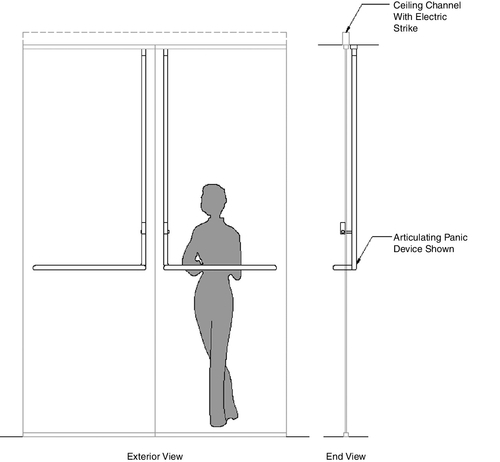
Hi-Tower Locks
Hi-Tower locks were developed to accommodate the needs of securing fire stairwell doors in compliance with local, state, and national codes and doing so in a fashion that will not violate the fire rating of the stairwell door assembly.
I was once called to assist a building manager of a 31-story high-rise office building in San Francisco; he had given the job of electrifying the stairwell doors to the lowest bidder, whose number was significantly lower than the next lowest bidder. The unfortunate security contractor was not familiar with fire code and had commenced to cut electric strikes into the door frames of 8 of the 35 floors of the building when the fire inspector happened to be in the building and noticed this. The fire inspector sought out the building manager, advising him that this practice destroyed the fire integrity of the fire stairwell 2-hour door assemblies and violated the law, rendering the building’s certificate of occupancy void on the spot.
Hi-Tower locks get around this problem by placing the lock in the door frame within a rated electrical enclosure that replaces the existing strike pocket, and this lock activates a mechanical release within a specially modified mortise lock that exactly replaces the original mortise lock. The lock is fire rated, and virtually every fire authority accepts it. A variance is typically required.
High-Security Locks
A few manufacturers make very high-security locks that can be electrified.
High-Abuse Tolerant Locks
Securitech makes a lock that was created for the New York public housing market where door hardware abuse was prevalent. The lock has several unusual characteristics. It is an electrified mortise lock that is equipped with an extremely robust mechanism and two unique features: It has a break-away clutch handle that simply turns freely when struck sharply, and it can be equipped with an electrified deadbolt. These locks can be expected to last the life of the building (Fig. 7.15).
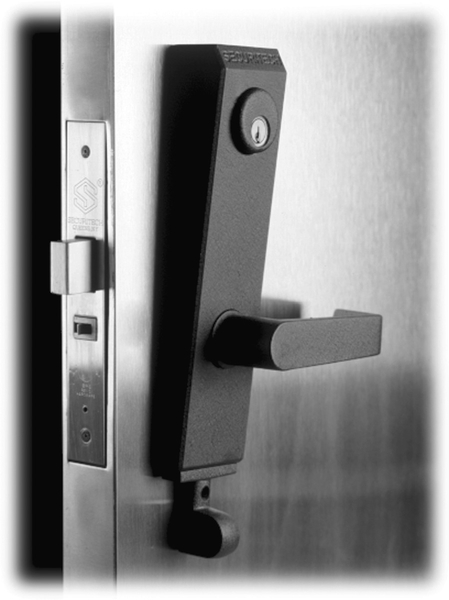
Electrified Dead Bolts
There are several locks on the market that supply electrified deadbolts. These are typically electrified mortise locks, although there are a few cases of simple electrified deadbolts. Typically, the deadbolt is triggered separately from the latchbolt on its own circuit. The lock is typically configured with an internal pawl that releases to allow the person exiting to turn the handle. When the inside handle is turned, it releases both the latchbolt and the deadbolt. The lock relatches automatically when the door closes, but the deadbolt must be re-engaged each time the door closes. This requires either a manual activation of the deadbolt or an electric activation of it, which can be configured by a monitor strike switch to lock the deadbolt after the door is closed and latched (Fig. 7.16).

One manufacturer makes an electrified deadbolt that relocks automatically with each door closure, having its own built-in monitor strike. In the past, a prevalent type of electrified deadbolt was a configuration that was mounted at the top of the door. These locks were available in either concealed or surface-mount types. This lock involved a deadbolt that was propelled down from the frame into a receiving pocket. Both the deadbolt and the receiving pocket were equipped with repelling magnets. When power was released, the deadbolt was propelled back up by magnetic repulsion. There have been some reports of problems with shifting of the door frame over time, causing a binding of this type of deadbolt. This type of deadbolt has fallen out of favor due to this fact and is no longer permitted on occupied spaces in some municipalities, where its use is limited to storerooms.
Multi-Point Locks
Multi-point locks are very secure compared to typical locks. Multi-point locks are secured at the hinge side, at the latch side, and top and (sometimes) at the bottom. This application is useful on doors that are likely to be attacked with tools such as a frame spreader. At least one manufacturer makes these locks in an electrified version (Fig 7.17).

Locks to Avoid
Electrified Cylinder Locks
Cylinder locks are very weak and cannot withstand even modest breaching attempts. These locks were electrified in order to facilitate remote access through a door under light duty in extremely low-threat areas, such as at a doctor’s office. Electrified cylinder locks will not stand up to continuous duty or a solid kick.
Lightweight Strikes
A few electric strikes are strong enough to be considered security devices, but most should not be relied on for high-security environments. Unfortunately, most electric strikes are not rated for their strength, making it difficult to determine whether one should rely on them to resist a forced attack. Any strike that does not list its physical strength should be assumed to be incapable of resisting a forced attack.
One of the favorable attributes of electric strikes is that they do not draw power except when they unlock. This makes them suitable for environments in which power availability is a concern.
Concerns About Special Knowledge
Wherever possible, I prefer to design locking systems that require no special knowledge to operate and that have free mechanical egress (not relying on electronics to unlock the door to exit). This is consistent with the basic principles of free egress outlined in the National Fire Protection Association (NFPA) Section 101, which has been adopted by most states and municipalities throughout the United States. Similar codes and regulations apply in virtually every country. It is inadvisable, and usually illegal, to design locking systems that require special knowledge or the ability to read signage in order to exit a fire egress space. We advance that it is inadvisable almost anywhere.2
Summary
There is no security without physical security. Effective access control design requires a comprehensive knowledge of physical security. Understanding door types is basic to designing access control. Door types include hollow metal, solid core, glass storefront, and Herculite doors and also specialized doors, including Total Doors, balanced doors, and historical doors. Other specialty doors include revolving doors, security doors, blast doors, and soundproof doors.
Door hardware is the bits and pieces that hang the door in the frame and adapt it to its operating environment. These include hinges and pivots, handles, levers, push bars and paddles, door closers and door coordinators, and automatic door operators. Door frame types include hollow metal, formed aluminum, extruded aluminum, wood, and frameless glass openings. Specialty frames include high-security frames and blast and soundproof frames.
Pedestrian gates are openings in fences and buildings that are not intended to defend against the weather. Pedestrian gates include chain-link gates, estate-type gates, and reinforced frame gates.
Occupancy ratings determine what kind of doors must be used, the widths of corridors, the types of door frames, and appropriate door hardware.
Common electrified locks include electrified mortise locks, magnetic locks, strikes, and electrified panic hardware. Push-to-exit buttons or panic bar switches should be used with all magnetic locks, in addition to any other automatic unlocking exit method. All electrified locks should use an interface to the building’s fire alarm system to ensure that locks are unlocked automatically in the event of a fire in the building, thus ensuring free egress. Delayed egress hardware provides for securing an exit door against improper use while ensuring that it is available for exit during an emergency. For all electrified locks, fire authority approval is required. Local codes vary, so the designer should know the local interpretation of national and state codes and any local codes. Electrified panic hardware ensures that high-volume exit doors can function in an emergency while providing access control. Specialty door hardware includes monitor strikes, Blumcraft hardware, and Hi-Tower locks. Other specialty locks include high-security locks, such as high-abuse locks, electrified deadbolts, and four-point electrified locks. Locks to avoid include electrified cylinder locks and lightweight strikes. NFPA Section 101 is the primary reference for life safety regulations and should be known by all security system designers. It is a good rule to design electrified locks for use with no special knowledge and free mechanical egress.
Questions and Answers
1. The most basic physical security is:
b. Physical architecture and landscaping of a facility
c. Ditches around a facility
d. None of the above
2. For access control, the most basic physical security tools are:
b. Locks
c. Both doors and locks
d. None of the above
3. Typical door construction types include:
b. Solid core doors
c. Glass storefront doors and frameless glass (Herculite) doors
d. All of the above
4. Which below is not a “specialty door”?
b. Total Doors
c. Balanced doors
d. Unbalanced doors
5. Which device is at the top and bottom of a door?
b. Pivot
c. Right-hand swing
d. None of the above
6. Which of the following is the strongest and most secure type of common door frames?
b. Formed aluminum frame
c. Soundproof frame
d. Extruded aluminum frame
7. Fire exit doors should always swing:
b. Outward
c. Both inward and outward
d. None of the above
8. One of the weakest types of common locks is:
b. Electrified mortise locks
c. Electrified cylinder locks
d. None of the above
9. Which below is not a common exit device?
a. Request-to-Exit (REX) sensor
b. Delayed egress hardware
c. Panic bar
d. Kick-plate
10. The strongest type of lock is a(n):
b. Multi-point lock
c. Electrified cylinder lock
d. Electrified door operator
Answers: 1: b, 2: c, 3: d, 4: d, 5: b, 6: a, 7: b, 8: c, 9: d, 10: b
